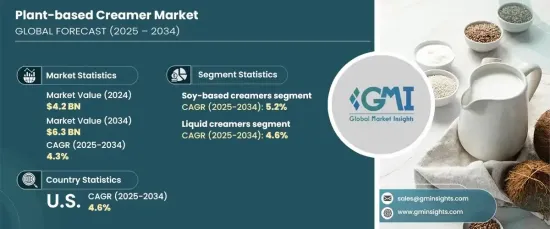
|
시장보고서
상품코드
1667071
식물성 크리머 시장 : 기회, 성장 촉진요인, 산업 동향 분석, 예측(2025-2034년)Plant-based Creamer Market Opportunity, Growth Drivers, Industry Trend Analysis, and Forecast 2025-2034 |
||||||
세계의 식물성 크리머 시장은 2024년에는 42억 달러로 평가되었고, 2025년부터 2034년까지의 CAGR 성장률은 4.3%로 예측되고 있습니다.
이러한 수요 급증의 배경은 기존 유제품을 대체하는 더 건강한 제품을 찾는 소비자 증가를 포함합니다. 식물성 크리머는 포화 지방과 콜레스테롤의 수준이 낮기 때문에 매력적인 선택이 되고 있으며, 채식주의자, 락토스 프리, 유제품 미사용 등 식생활의 기호를 가진 사람들에게 적합한 옵션을 제공합니다.

비건과 유제품 미사용 식생활의 보급도 이 동향에 크게 기여하고 있습니다. 이 크리머는 유제품을 섭취하지 않기로 선택하거나 유제품을 견딜 수없는 사람들에게 이상적인 대체품으로 작용하여 시장 확대를 더욱 강화하고 있습니다. 건강과 웰빙에 대한 관심이 높아짐에 따라 식물 유래식이 요법이 선호되고, 많은 소비자가 소화기계의 건강을 지원하고, 콜레스테롤을 낮추고 심장 질환의 위험을 줄이기 위해이 크리머를 사용합니다. 지속가능성과 윤리적 배려가 소비자의 선택에 큰 역할을 함에 따라, 식물 유래의 대안은 보다 친환경적인 선택으로 간주됩니다.
| 시장 범위 | |
|---|---|
| 시작 연도 | 2024 |
| 예측 연도 | 2025-2034년 |
| 시작 금액 | 42억 달러 |
| 예측 금액 | 63억 달러 |
| CAGR | 4.3% |
그러나, 식물성 크리머는 특히 소비자가 기존의 유제품 크리머에 기대하는 맛과 식감을 실현하는 데 있어서 과제에 직면하고 있습니다. 더 건강한 대안으로 인식되는 경우가 많지만 식물 유래 옵션, 특히 견과류와 콩 유래 옵션은 과민증 환자에게 알레르겐 우려를 유발할 수 있습니다. 이러한 장애에도 불구하고 식물성 크리머 시장은 계속 기세를 늘리고 있습니다. 특히 많은 음식 및 음료 제조업체들이 이 수요 증가에 부응하기 위해 비건 및 채식주의자 제품의 제공을 확대하고 있습니다.
이 시장에서 대두 기반 크리머는 합리적인 가격과 높은 단백질 함량 덕분에 여전히 큰 점유율을 차지합니다. 한편, 아몬드 기반 크리머는 낮은 칼로리로 인해 건강 지향적 인 사람들에게 호소합니다. 귀리 기반 선택은 크림 같은 질감과 요리와 음료 모두의 유연성으로 인해 급속히 상승합니다. 쌀, 캐슈넛, 대마, 마카다미아 너트로 만든 것 등 다른 식물성 크리머도 소비자의 다양한 요구를 충족하는 데 있어서 기술 혁신이 중요한 역할을 계속하고 있기 때문에 존재감을 늘리고 있습니다.
액체 식물성 크리머가 시장을 독점하고 2024년에는 점유율의 60% 이상을 차지했습니다. 편리함, 사용의 용이성, 커피와 같은 음료에 부드럽게 친숙해지는 능력으로 지지되고 있습니다. 한편, 분말 크리머의 인기는 높아지고 있어, 특히 보존 기간이 길고 운반하기 쉽기 때문에 냉장실이 한정되어 있는 지역의 소비자에게 이상적입니다.
미국에서는 유제품이 없는 대체품에 대한 수요가 증가함에 따라 식물성 크리머 시장은 2034년까지 21억 달러에 달할 것으로 예상됩니다. 이 동향은 건강 지향 소비자뿐만 아니라 식물성 식생활로의 전환이 현저해지고 있는 것도 뒷받침하고 있습니다. 소매점과 온라인 판매 채널도 맛과 영양 측면에서의 이점을 개선하는 데 각 회사가 주력함으로써 이러한 제품의 가용성을 확대하고 있습니다. 시장이 진화하는 소비자의 취향에 적응함에 따라 지속 가능한 포장과 조달은 많은 제조업체들에게 중요한 고려 사항이 되었습니다.
목차
제1장 조사 방법과 조사 범위
- 시장 범위와 정의
- 기본 추정과 계산
- 예측 계산
- 데이터 소스
- 1차 데이터
- 2차 데이터
- 유료 정보원
- 공적 정보원
제2장 주요 요약
제3장 업계 인사이트
- 생태계 분석
- 밸류체인에 영향을 주는 요인
- 이익률 분석
- 방해
- 장래의 전망
- 제조업체
- 유통업체
- 공급자의 상황
- 이익률 분석
- 주요 뉴스와 대처
- 규제 상황
- 영향요인
- 업계에 미치는 영향요인
- 성장 촉진요인
- 대체 유제품에 대한 소비자 수요 증가
- 건강 의식 및 식물성 식단 증가
- 비건 및 채식주의자 제품 확대
- 시장의 과제
- 식물성 크리머 원료의 가격 변동
- 성장 촉진요인
- 규제와 시장에 미치는 영향
- Porter's Five Forces 분석
- PESTEL 분석
제4장 경쟁 구도
- 소개
- 기업 점유율 분석
- 경쟁 포지셔닝 매트릭스
- 전략 전망 매트릭스
제5장 시장 규모와 예측 : 제품 유형별(2021-2034년)
- 주요 동향
- 대두 기반 크리머
- 아몬드 기반 크리머
- 귀리 기반 크리머
- 코코넛 기반 크리머
- 쌀 기반 크리머
- 기타 식물성 크리머
제6장 시장 규모와 예측 : 형태별(2021-2034년)
- 주요 동향
- 액체 크리머
- 분말 크리머
제7장 시장 규모와 예측 : 풍미별(2021-2034년)
- 주요 동향
- 오리지널/무향
- 바닐라
- 헤이즐넛
- 초콜릿
- 카라멜
- 기타
제8장 시장 규모와 예측 : 유통 채널별(2021-2034년)
- 주요 동향
- 슈퍼마켓/하이퍼마켓
- 편의점
- 온라인 소매
- 전문점
- 소비자 직접 판매(DTC)
제9장 시장 규모와 예측 : 최종 용도별(2021-2034년)
- 주요 동향
- 커피숍 및 카페
- 소매
- 푸드서비스
- 베이커리 및 과자류
- 기타
제10장 시장 규모와 예측 : 지역별(2021-2034년)
- 주요 동향
- 북미
- 미국
- 캐나다
- 유럽
- 영국
- 독일
- 프랑스
- 이탈리아
- 스페인
- 러시아
- 아시아태평양
- 중국
- 인도
- 일본
- 한국
- 호주
- 라틴아메리카
- 브라질
- 멕시코
- 중동 및 아프리카
- 남아프리카
- 사우디아라비아
- 아랍에미리트(UAE)
제11장 기업 프로파일
- Chobani
- Danone
- Fage
- General Mills
- Greek Gods
- La Yogurt
- Lifeway Foods
- Nestlé
- Stonyfield Farms
- Valio
- Yakult
- Yoplait
The Global Plant-Based Creamer Market was valued at USD 4.2 billion in 2024, with projections indicating a growth rate of 4.3% CAGR from 2025 to 2034. This surge in demand is being driven by an increasing number of consumers seeking healthier alternatives to traditional dairy products. Plant-based creamers are becoming an attractive option due to their lower levels of saturated fats and cholesterol, offering a more suitable choice for those with dietary preferences such as vegan, lactose-free, or dairy-free.

The growing adoption of vegan and dairy-free diets is also significantly contributing to this trend. These creamers serve as an ideal substitute for people who either choose not to consume or cannot tolerate dairy, further pushing the market's expansion. The heightened focus on health and wellness has made plant-based diets a preferred choice, with many consumers turning to these creamers to support better digestive health, lower cholesterol, and reduce the risk of heart disease. As sustainability and ethical considerations play a bigger role in consumer choices, plant-based alternatives are increasingly seen as a more environmentally responsible option.
| Market Scope | |
|---|---|
| Start Year | 2024 |
| Forecast Year | 2025-2034 |
| Start Value | $4.2 Billion |
| Forecast Value | $6.3 Billion |
| CAGR | 4.3% |
However, plant-based creamers face challenges, particularly in achieving the taste and texture that consumers expect from traditional dairy creamers. While they are often perceived as a healthier alternative, certain plant-based options, particularly those derived from nuts or soy, can cause allergen concerns for individuals with sensitivities. Despite these obstacles, the plant-based creamer market continues to gain momentum, particularly as more food and beverage manufacturers expand their vegan and vegetarian product offerings to cater to this rising demand.
Within this market, soy-based creamers continue to hold a significant share, thanks to their affordable price and high protein content. Meanwhile, almond-based creamers are appealing to health-conscious individuals due to their lower calorie content. Oat-based options are gaining ground rapidly, driven by their creamy texture and flexibility in both cooking and beverages. Other plant-based creamers, such as those made from rice, cashews, hemp, and macadamia nuts, are also expanding their presence as innovation continues to play a key role in meeting diverse consumer needs.
Liquid plant-based creamers dominate the market, accounting for over 60% of the share in 2024. They are favored for their convenience, ease of use, and ability to blend smoothly in beverages like coffee. On the other hand, powdered creamers are becoming more popular, particularly due to their extended shelf life and portability, making them ideal for consumers in areas with limited refrigeration access.
In the U.S., the plant-based creamer market is expected to reach USD 2.1 billion by 2034, supported by a growing demand for dairy-free alternatives. This trend is not only fueled by health-conscious consumers but also by a more prominent shift toward plant-based diets. Retail and online sales channels have also expanded the availability of these products, with companies focusing on improving both taste and nutritional benefits. As the market adapts to evolving consumer preferences, sustainable packaging and sourcing are becoming key considerations for many manufacturers.
Table of Contents
Chapter 1 Methodology & Scope
- 1.1 Market scope & definition
- 1.2 Base estimates & calculations
- 1.3 Forecast calculation
- 1.4 Data sources
- 1.4.1 Primary
- 1.4.2 Secondary
- 1.4.2.1 Paid sources
- 1.4.2.2 Public sources
Chapter 2 Executive Summary
- 2.1 Industry synopsis, 2021-2034
Chapter 3 Industry Insights
- 3.1 Industry ecosystem analysis
- 3.1.1 Factor affecting the value chain
- 3.1.2 Profit margin analysis
- 3.1.3 Disruptions
- 3.1.4 Future outlook
- 3.1.5 Manufacturers
- 3.1.6 Distributors
- 3.2 Supplier landscape
- 3.3 Profit margin analysis
- 3.4 Key news & initiatives
- 3.5 Regulatory landscape
- 3.6 Impact forces
- 3.7 Industry impact forces
- 3.7.1 Growth drivers
- 3.7.1.1 Rising consumer demand for dairy alternatives
- 3.7.1.2 Increased health consciousness and plant-based diets
- 3.7.1.3 Expansion of vegan and vegetarian product offerings
- 3.7.2 Market challenges
- 3.7.2.1 Price volatility of raw materials for plant-based creamers
- 3.7.1 Growth drivers
- 3.8 Regulations & market impact
- 3.9 Porter’s analysis
- 3.10 PESTEL analysis
Chapter 4 Competitive Landscape, 2024
- 4.1 Introduction
- 4.2 Company market share analysis
- 4.3 Competitive positioning matrix
- 4.4 Strategic outlook matrix
Chapter 5 Market Size and Forecast, By Product Type, 2021-2034 (USD Billion) (Tons)
- 5.1 Key trends
- 5.2 Soy-based creamers
- 5.3 Almond-based creamers
- 5.4 Oat-based creamers
- 5.5 Coconut-based creamers
- 5.6 Rice-based creamers
- 5.7 Other plant-based creamers
Chapter 6 Market Size and Forecast, By Form, 2021-2034 (USD Billion) (Tons)
- 6.1 Key trends
- 6.2 Liquid creamers
- 6.3 Powdered creamers
Chapter 7 Market Size and Forecast, By Flavor, 2021-2034 (USD Billion) (Tons)
- 7.1 Key trends
- 7.2 Original/Unflavored
- 7.3 Vanilla
- 7.4 Hazelnut
- 7.5 Chocolate
- 7.6 Caramel
- 7.7 Others
Chapter 8 Market Size and Forecast, By Distribution Channel, 2021-2034 (USD Billion) (Tons)
- 8.1 Key trends
- 8.2 Supermarkets and hypermarkets
- 8.3 Convenience stores
- 8.4 Online retail
- 8.5 Specialty stores
- 8.6 Direct-to-consumer (DTC)
Chapter 9 Market Size and Forecast, By End Use, 2021-2034 (USD Billion) (Tons)
- 9.1 Key trends
- 9.2 Coffee shops and cafes
- 9.3 Retail
- 9.4 Foodservice
- 9.5 Bakery and confectionery
- 9.6 Others
Chapter 10 Market Size and Forecast, By Region, 2021-2034 (USD Billion) (Tons)
- 10.1 Key trends
- 10.2 North America
- 10.2.1 U.S.
- 10.2.2 Canada
- 10.3 Europe
- 10.3.1 UK
- 10.3.2 Germany
- 10.3.3 France
- 10.3.4 Italy
- 10.3.5 Spain
- 10.3.6 Russia
- 10.4 Asia Pacific
- 10.4.1 China
- 10.4.2 India
- 10.4.3 Japan
- 10.4.4 South Korea
- 10.4.5 Australia
- 10.5 Latin America
- 10.5.1 Brazil
- 10.5.2 Mexico
- 10.6 MEA
- 10.6.1 South Africa
- 10.6.2 Saudi Arabia
- 10.6.3 UAE
Chapter 11 Company Profiles
- 11.1 Chobani
- 11.2 Danone
- 11.3 Fage
- 11.4 General Mills
- 11.5 Greek Gods
- 11.6 La Yogurt
- 11.7 Lifeway Foods
- 11.8 Nestlé
- 11.9 Stonyfield Farms
- 11.10 Valio
- 11.11 Yakult
- 11.12 Yoplait


















